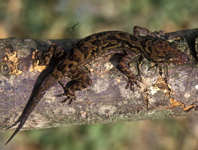Abstract
Here we establish a neotype for Alatina alata (Reynaud, 1830) from the Dutch Caribbean island of Bonaire. The species was originally described one hundred and eighty three years ago as Carybdea alata in La Centurie Zoologique—a monograph published by René Primevère Lesson during the age of worldwide scientific exploration. While monitoring monthly reproductive swarms of A. alata medusae in Bonaire, we documented the ecology and sexual reproduction of this cubozoan species. Examination of forty six A. alata specimens and additional archived multimedia material in the collections of the National Museum of Natural History, Washington, DC revealed that A. alata is found at depths ranging from surface waters to 675 m. Additional studies have reported it at depths of up to 1607 m in the tropical and subtropical Atlantic Ocean. Herein, we resolve the taxonomic confusion long associated with A. alata due to a lack of detail in the original description and conflicting statements in the scientific literature. A new cubozoan character, the velarial lappet, is described for this taxon. The complete description provided here serves to stabilize the taxonomy of the second oldest box jellyfish species, and provide a thorough redescription of the species.

